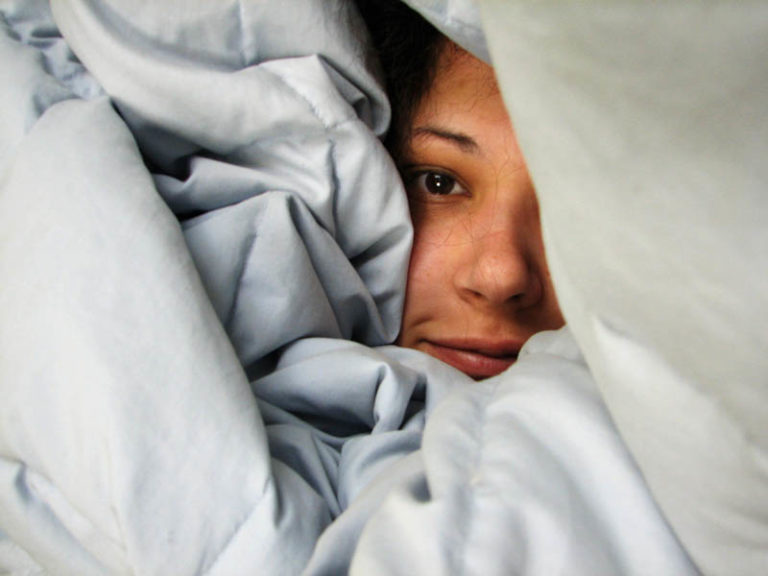
Image by Jamelah E./Flickr (CC BY-NC 2.0)..
Mastering the Hong and the Sau
There are different kinds of breaths — the kind that helps you live, and the kind that helps you meditate.
Breathing is something that’s universal, an act that all humans do to survive regardless of age, gender, or ethnicity. But when my journalism class went to the Ananda ashram in Pune, India, I learned that a breath can be more than just a way to survive.
Ananda is a community originally founded in Nevada City, California, which has since established dozens of centers worldwide. Offering a version of Hinduism with Christian principles, the religious movement promotes success and happiness through meditation and communal living.
On our second day at the ashram, we took a breathing and meditation class with Jamal, a yellow-clad monk who lived in the monastery nearby. American-born and a Yale graduate, Jamal was genuinely curious about our work and our lives back in the States. During one meal, we happily told him about the latest tech trends like the multitude of Lyft’s pink mustaches on the roads and the various online dating platforms that come straight through your smartphone. Rather than showing disdain for what some might consider “worldly” things, Jamal was intrigued.
“I gotta see this for myself,” he told us, laughing.
It was jarring to hear a spiritual man take such an interest in modern-day technology. It was probably my misguided perception of monks as self-isolated folks who murmur wise maxims. And in my mind, they were always bald.
So when the jovial Jamal and his waist-long dreads stood at the front of the makeshift temple, I wasn’t sure how our meditation class would play out. A whiz who helped develop an eco-friendly and self-sustaining irrigation system at Ananda’s original community in California, Jamal was a tech savvy guy living a monk’s life. Would his mastery of systems translate in a very spiritual retreat?
During the class, Jamal’s boisterous laughter, which often would herald his arrival before he entered a room, was absent. This was Jamal the Monk, not Jamal the Whiz Kid. He spoke patiently and eloquently, carefully explaining different breathing techniques that would act as warm-up before the real meditation began.
Inhale two breaths, he said — one short, one long. And exhale — one short, one long. Inhale — count one, two, three, four five. Exhale — count one, two, three, four, five.
The eight of us who gathered for the class sat cross-legged, our palms open, turned upward and resting on our thighs. Eyes shut, we listened to Jamal’s quiet instruction. Our cacophony of gasps echoed Jamal’s counts, and it felt like a Hindu call-and-response lullaby.
Already I felt my mind drifting off without a single thought. Maybe it was the jet lag. After all, it did take us 20 straight hours of travel to get this isolated corner in India’s countryside. Perhaps because my body was receiving more oxygen than it was used to, I was entering an O2-induced state of Nirvana. Or maybe, just maybe, the breathing exercises were working.
After about 10 minutes of opening our lungs and shutting down our thoughts, Jamal explained a basic meditation called hong sau.
Hong sau means “I am He” or “I am Spirit.” During this meditation, we are supposed to focus all of our attention on our breaths, thinking hong when we inhale and sau when we exhale.
Inhale, hong — I am. Exhale, sau — Spirit.
Jamal instructed us to breathe at a normal rate. To slow the natural ebb and flow of our air intake would draw away from our attempts to retreat into ourselves, to lose ourselves in deep meditation, free from the worldly worries that we sought to escape.
I lasted no more than five seconds. Just when I thought I was edging toward a deeper state of consciousness, I would think how surprised I was that it was working. And that would immediately transport me back to the temple’s weathered blue carpet.
During the 30-minute meditation, I’d take a small peek now and then at my fellow meditators. A few looked like they were in the same heavily oxygenated state as Jamal. Their focused breathing helped relax their face muscles, which revealed small slivers of white upturned eyes. And then I would see a slight twitch in someone’s face or a gulp of air inhaled off-tempo.
I wasn’t alone in my inability to breathe like a monk.
The meditation made me realize that real breathing is actually very difficult to master. So easily do we take for granted our body’s respiratory system that keeps us moving — and living.
Like his extensive irrigation and filtration system, Jamal’s breaths could permeate the veins in his body and expel his ties to the tangible. He had found a way to take his scientific knowledge and apply it to something spiritual.
Since being back in Los Angeles, I’ve taken a few moments to think hong sau during small breaks in my life — a walk to my car, a pause in writing.
Sure, I might still be very much plugged into the real world when I hong sau myself. But every time I think those words that Jamal taught me, it’s like a mini-retreat that takes me back to Ananda, one breath at a time.

Share your reflection